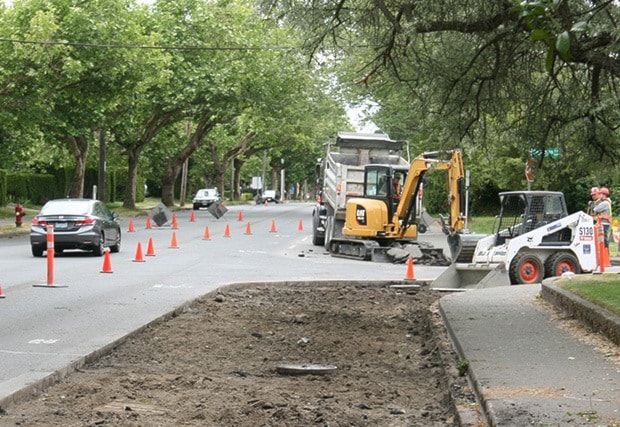He’s known in the forestry community as an outside of the box thinker and now Ray Travers, the former president of the Gordon Head Resident Association, has turned his focus on improving transit through the Shelbourne Valley.
Health complications have slowed the former conflict resolution specialist, but he’s still able to do the things he wants to. On his breakfast table is a pile of design and information books, reference material he uses to guide his ongoing analysis of what he thinks are missed priorities for the Shelbourne Valley Action Plan.
To be fair, the retiree, who once specialized in environmental conflict resolution for the province, is in favour of the current proposal that the planning department is set to bring forward in the fall.
In his mind, the narrowing of Shelbourne from four lanes to two lanes is a road diet. The common effects of a road diet are to add continuous cycling lanes, which Saanich will do, as that was the most supported issue during the SVAP public input period in February and March.
One Saanich report says that narrowing Shelbourne to two lanes would divert 6,000 to 9,000 vehicles per day to Cedar Hill and Richmond roads. However, Travers says, there’s a danger of false theories, especially that traffic will flow like water.
“It’s just not the case,” Travers says.
A 2011 Malatest report showed the top-five daily morning destinations for travellers leaving Saanich East. According to the Malatest data, the University of Victoria far outweighed the rest, drawing 40 per cent, or 14,343 trips. Only 4,000 actually continued downtown (11.6 per cent) while 3,298 (9.4 per cent) went to Oak Bay, 2,877 (8.2 per cent) to Vic South and 2,578 (7.3 per cent) to Vic North. That accounted for 27,178 trips, or 77.2 per cent of the total.
Travers says the fact most traffic does not make it to Victoria is proof Shelbourne does not need to be four lanes.
“It was said by one planner that, when cycling and other mobility is made safer, some oddballs might even ride their bike or walk,” Travers joked.
Until the road diet is made permanent, however, Travers has his reservations about the SVAP.
“This is a good thing, road diets work though some people don’t like the name, for whatever reason,” Travers said, even though “they’re proven to lead to less crashes and improved safety.”
The SVAP, for instance, does not use the term road diet, notes Travers, although the current hybrid option is just that.
One thing Travers is happy about is that the SVAP moved away from the term corridor, and uses the term Shelbourne Valley instead. It was something he played a part in when he was a member of the initial 2009 stakeholders committee. He left after three years, citing a lack of progress. Of course, that’s nothing new, as many, including councillors, have openly scoffed at the SVAP as a strategy that could take 30 years to implement, to which planning responded with the current hybrid option.
Travers credits the current project lead, Cam Scott, for bringing the SVAP along as far as he has.
“In a lot of ways the planners have no choice,” he said, referring to the district’s refusal to expropriate land beyond the right-of-ways. “They’re doing what they can within [sometimes unseen] limits.”
What worries Travers most is if Shelbourne was to somehow remain a four-lane road, or one day return to one. Though that is not the current plan, Travers wants to see any reference to Shelbourne as a four-lane road removed from the SVAP, and OCP, for good.
“It’s a 1950s response to add capacity to a road and it’s proven over and over that when roads are expanded they will soon fill to capacity once again,” Travers said. “There’s also a significant issue missing, and that is safety as a key priority.”
Safety, as a concept, is at the top of Seattle’s and other leading municipalities’ traffic planning priorities. While it is included in the SVAP, Travers would like to see it highlighted as a priority throughout.
In the meantime, Travers is looking forward to the completed proposal expected in the early fall.
